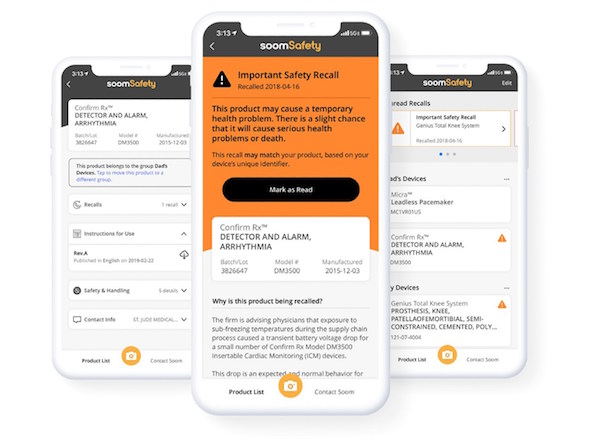 Health and Human Services Secretary Tom Price, M.D. today announced the selection of five entrepreneurial projects for investment by the Secretary’s Ventures Fund (HHS Ventures). The projects were chosen from across HHS and are part of the latest round of funding and support designed to advance the Department’s innovation agenda... HHS Ventures is a highly competitive effort that provides growth-stage funding and support to HHS employees with proven ideas for how to dramatically improve their office, agency, or the Department’s ability to carry out its mission...
Health and Human Services Secretary Tom Price, M.D. today announced the selection of five entrepreneurial projects for investment by the Secretary’s Ventures Fund (HHS Ventures). The projects were chosen from across HHS and are part of the latest round of funding and support designed to advance the Department’s innovation agenda... HHS Ventures is a highly competitive effort that provides growth-stage funding and support to HHS employees with proven ideas for how to dramatically improve their office, agency, or the Department’s ability to carry out its mission...US Food and Drug Administration (FDA)
See the following -
Peer into the Post-Apocalyptic Future of Antimicrobial Resistance
Aout 4 million years ago, a cave was forming in the Delaware Basin of what is now Carlsbad Caverns National Park in New Mexico. From that time on, Lechuguilla Cave remained untouched by humans or animals until its discovery in 1986—an isolated, pristine primeval ecosystem. When the bacteria found on the walls of Lechuguilla were analyzed, many of the microbes were determined not only to have resistance to natural antibiotics like penicillin, but also to synthetic antibiotics that did not exist on earth until the second half of the twentieth century...
- Login to post comments
Peer into the Post-Apocalyptic Future of Antimicrobial Resistance
Aout 4 million years ago, a cave was forming in the Delaware Basin of what is now Carlsbad Caverns National Park in New Mexico. From that time on, Lechuguilla Cave remained untouched by humans or animals until its discovery in 1986—an isolated, pristine primeval ecosystem. When the bacteria found on the walls of Lechuguilla were analyzed, many of the microbes were determined not only to have resistance to natural antibiotics like penicillin, but also to synthetic antibiotics that did not exist on earth until the second half of the twentieth century...
- Login to post comments
Questions About The FDA’s New Framework For Digital Health
 In June 2017, the new Food and Drug Administration (FDA) commissioner Scott Gottlieb pre-announced his agency’s Digital Health Innovation Action Plan that indicates notable shifts in the agency’s approach to digital health technologies. This plan is an important step in FDA regulation of this area, a process that began in 2011 with a draft guidance, followed by significant congressional actions. The new changes should not be surprising, given critiques published by Gottlieb prior to re-joining the FDA...
In June 2017, the new Food and Drug Administration (FDA) commissioner Scott Gottlieb pre-announced his agency’s Digital Health Innovation Action Plan that indicates notable shifts in the agency’s approach to digital health technologies. This plan is an important step in FDA regulation of this area, a process that began in 2011 with a draft guidance, followed by significant congressional actions. The new changes should not be surprising, given critiques published by Gottlieb prior to re-joining the FDA...
- Login to post comments
Rep. Tulsi Gabbard Urges the USDA to Make GMO-Labeling Transparent, Accessible
 As the U.S. Department of Agriculture (USDA) develops final rules on GMO-labeling requirements over the next year, Rep. Tulsi Gabbard (HI-02) and fellow lawmakers called on Secretary Perdue to ensure labeling standards are consumer-friendly, fair, and transparent. In July 2016, Congress passed weak GMO labeling standards into law that create a confusing web of disclosure options, allowing companies to choose between on-package text, a USDA-regulated symbol, or an electronic or digital link (e.g., QR code)...
As the U.S. Department of Agriculture (USDA) develops final rules on GMO-labeling requirements over the next year, Rep. Tulsi Gabbard (HI-02) and fellow lawmakers called on Secretary Perdue to ensure labeling standards are consumer-friendly, fair, and transparent. In July 2016, Congress passed weak GMO labeling standards into law that create a confusing web of disclosure options, allowing companies to choose between on-package text, a USDA-regulated symbol, or an electronic or digital link (e.g., QR code)...
- Login to post comments
Social Medicine 2.0—Can You Use Crowdsourcing to Give Your Medical Device a Leg Up?
 Online crowdsourcing communities are a game changer. These platforms allow anyone to appeal to the entire connected world for support or participation. They get many of us to participate—Kickstarter processed just shy of $500 million dollars in 2014. Most interesting, at least to me, are platforms for crowdsourcing information. These make up the next generation of online forums, ranging from chat forums to open source hardware development...
Online crowdsourcing communities are a game changer. These platforms allow anyone to appeal to the entire connected world for support or participation. They get many of us to participate—Kickstarter processed just shy of $500 million dollars in 2014. Most interesting, at least to me, are platforms for crowdsourcing information. These make up the next generation of online forums, ranging from chat forums to open source hardware development...
- Login to post comments
Soom Launches Mobile App That Notifies Patients, Caregivers and Nurses of Medical Device Recalls
 Soom, a pioneer in utilizing barcode and knowledge graph technologies to bridge information gaps between data sources and physical products, has introduced SoomSafety, an iOS mobile app that allows users to scan a medical device and receive instructions for use, safety and recall information directly from the device manufacturer and U.S. Food and Drug Administration (FDA). "We built SoomSafety to help patients and caregivers relying on implanted medical devices and using medical devices at home answer one critical question, 'Is this medical device safe to use?'" said Charlie Kim, President and CEO of Soom. "Our technology makes it possible to connect previously siloed medical device data, giving patients-and their caregivers-more proactive control over their health and safety."
Soom, a pioneer in utilizing barcode and knowledge graph technologies to bridge information gaps between data sources and physical products, has introduced SoomSafety, an iOS mobile app that allows users to scan a medical device and receive instructions for use, safety and recall information directly from the device manufacturer and U.S. Food and Drug Administration (FDA). "We built SoomSafety to help patients and caregivers relying on implanted medical devices and using medical devices at home answer one critical question, 'Is this medical device safe to use?'" said Charlie Kim, President and CEO of Soom. "Our technology makes it possible to connect previously siloed medical device data, giving patients-and their caregivers-more proactive control over their health and safety."
- Login to post comments
The $100,000-Per-Year Pill: How US Health Agencies Choose Pharma Over Patients
Don Reichmuth survived prostate cancer once before, back in 2007, so his physician was concerned when tests recently revealed the cancer had returned. Reichmuth's physician prescribed a drug called enzalutamide, marketed by the Japanese company Astellas Pharma, Inc. under the brand name Xtandi. But when the physician sent the prescription to the pharmacy, the managers of Reichmuth's insurance plan sent back an immediate refusal to approve it. Reichmuth, a retired teacher who lives in Washington State, was puzzled by the logic. Then he learned the price of the Xtandi prescription: over $9,700 each month...
- Login to post comments
The Secretary’s Ventures Fund Announces 2017 Projects
 Health and Human Services Secretary Tom Price, M.D. today announced the selection of five entrepreneurial projects for investment by the Secretary’s Ventures Fund (HHS Ventures). The projects were chosen from across HHS and are part of the latest round of funding and support designed to advance the Department’s innovation agenda... HHS Ventures is a highly competitive effort that provides growth-stage funding and support to HHS employees with proven ideas for how to dramatically improve their office, agency, or the Department’s ability to carry out its mission...
Health and Human Services Secretary Tom Price, M.D. today announced the selection of five entrepreneurial projects for investment by the Secretary’s Ventures Fund (HHS Ventures). The projects were chosen from across HHS and are part of the latest round of funding and support designed to advance the Department’s innovation agenda... HHS Ventures is a highly competitive effort that provides growth-stage funding and support to HHS employees with proven ideas for how to dramatically improve their office, agency, or the Department’s ability to carry out its mission...- Login to post comments
Tim Cook visits veterans and doctors at Palo Alto VA hospital, staff using iPads
Apple CEO Tim Cook on Thursday tweeted out a photo and brief message highlighting a recent visit to the Veterans Affairs hospital in Palo Alto, Calif., saying he was happy to meet with doctors who now use iPads to treat patients. Read More »
- Login to post comments
Too little research backs high-risk medical devices
The U.S. Food and Drug Administration's Premarket Approval pathway allows high-risk medical devices on the market with only one study to prove their safety and effectiveness, and there are a limited number of studies done post-market, according to research published in Journal of the American Medical Association. Medical device regulation in the U.S. is more rigorous than in other parts of the world, but "the difference is, in many European countries they have much better capacity to follow devices once they are in practice," senior author Joseph S. Ross, M.D., of the Yale University School of Medicine, told Reuters.
- Login to post comments
TransCelerate Identifies Pharmacovigilance as an Operational Challenge in Need of Transformation
 TransCelerate BioPharma Inc. today announced that it has added Pharmacovigilance to its portfolio, establishing two new global initiatives: 1.) Interpretation of Pharmacovigilance Regulations and 2.) Value of Safety Information Data Sources. Both initiatives aim to create solutions that will reduce resource inefficiencies, enhance information exchange with global health authorities and improve patient safety to drive more value for patients...
TransCelerate BioPharma Inc. today announced that it has added Pharmacovigilance to its portfolio, establishing two new global initiatives: 1.) Interpretation of Pharmacovigilance Regulations and 2.) Value of Safety Information Data Sources. Both initiatives aim to create solutions that will reduce resource inefficiencies, enhance information exchange with global health authorities and improve patient safety to drive more value for patients...
- Login to post comments
Waste from Pharmaceutical Plants in India and China Promotes Antibiotic-Resistant Superbugs
Superbugs, disease-causing microbes that have mutated to become resistant to antibiotics, are a threat to the lives of hundreds of thousands of people today and many millions tomorrow. These organisms turn curable illnesses such as tuberculosis, gonorrhea, and pneumococcal pneumonia into deadly ones. This looming public health disaster has many causes. Overuse of antibiotics by humans and the routine use of antibiotics to help farm animals grow faster are key causes in the United States. One worrisome cause that has received virtually no attention until now is wastewater from drug manufacturing facilities in India and China, where a large portion of the world’s antibiotic supply is produced...
- Login to post comments
When Evidence Says No, but Doctors Say Yes
Fiirst, listen to the story with the happy ending: At 61, the executive was in excellent health. His blood pressure was a bit high, but everything else looked good, and he exercised regularly. Then he had a scare. He went for a brisk post-lunch walk on a cool winter day, and his chest began to hurt. Back inside his office, he sat down, and the pain disappeared as quickly as it had come...
- Login to post comments